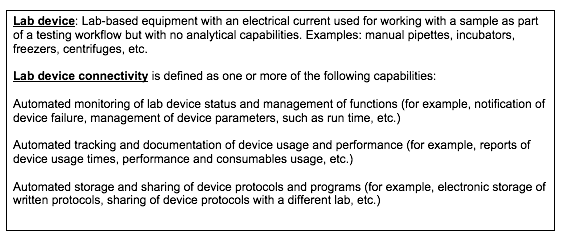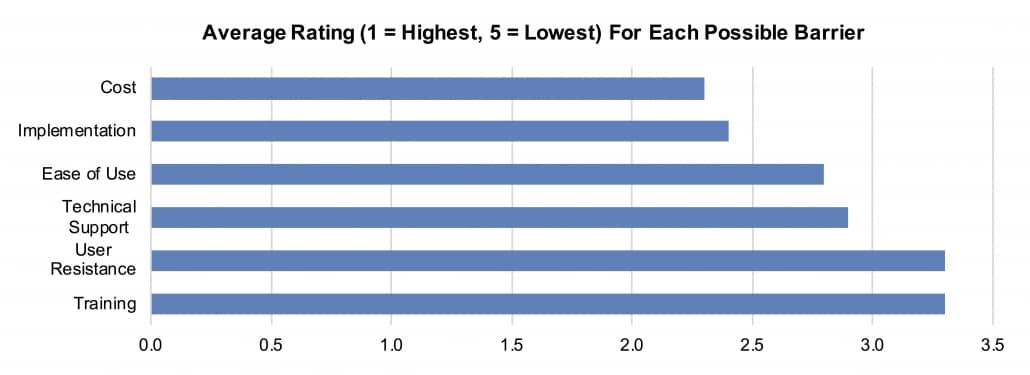Plugging Into Lab Connectivity: IBO Survey Examines Digitization in Labs
With digitization permeating nearly every aspect of daily life, it is no surprise that labs would also be riding the wave. While software embedded into or connected to lab equipment is not a new notion, software developments, the promise of big data, and the drive for increased productivity have spurred the rapid development of new solutions for lab connectivity (see box below for definitions) with more labs evaluating the potential benefits.
Lab device connectivity incorporates numerous types of solutions, from equipment monitoring and tracking to data storage and sharing. Numerous instrument and lab equipment providers, such as Gilson and Thermo Fisher Scientific, are now offering such solutions, embedded or as add-ons, aimed to making life in the lab both more productive and easier.
To assess the impact of lab connectivity, earlier this May, IBO conducted a survey of 210 qualified respondents using BioInformatics Inc.’s Science Advisory Board (SAB), an online community of scientific experts. The vast majority of respondents, or 64%, work at a biopharmaceutical or biotechnology company, while 21% and 7% of respondents are employed by pharmaceutical companies and CROs, respectively. The remaining 8% of respondents work in a variety of sectors, including academic, medical device, environmental testing, government, materials, commercial testing, and food and beverage labs.
Participants came from varied employment backgrounds, with 31% working as staff scientists, 29% as lab manager/director/supervisor/coordinators and 20% as principal investigators. The remaining 20% of survey respondents ranged from bioengineers, department heads, QA/QC coordinators to executives.
The terms as used in the survey are defined below:

Lab device connectivity appears not to be a new concept for these labs. Eighty percent of respondents have heard of it. However, only 50% of these labs currently utilize lab device connectivity via specialized lab equipment or software.
Although many respondents have heard of lab device connectivity, IBO also asked if they plan to implement it in their labs. According to the survey, it is definitely on the docket, with 116 respondents, over half, indicating that they plan to do so (see graph above). The remaining 76 respondents, or 36%, were split between being unsure or undecided.
As highlighted in the table above, some of the feature capabilities touted by lab connectivity technologies include automation of device monitoring status, tracking and documentation, and storage and sharing. Automation of device monitoring is a feature that researchers believe by a large margin adds the most value to the productivity of their labs (see graph above). However, automated storage and sharing of device protocols and programs was ranked by over half of respondents as offering the least value. Almost half of all respondents indicated that automated tracking and documentation of device usage and performance may offer a moderate amount of increased value in lab productivity.
Digitizing a lab may offers increased productivity and efficiency, but upgrading labs to be digitally connected may require a substantial investment that can impact budgets and staff training. Rather than ranking the possible barriers, respondents were asked to rate, with 1 indicating the highest barrier and 5 indicating the lowest barrier) six possible barriers (cost, ease of use, implementation, technical support, training, user resistance) (see graph above).
Not surprisingly, cost is considered a major barrier. The cost of incorporating connectivity in the lab received the highest average rating at 3.3 (see graph above). In fact, 37% of respondents rated it a 1, with over 50% rating it a 1 or 2. However, 13% rated it a 5 indicating they consider it a low barrier.
Twenty-one percent of respondents rated implementation as a 1, and 45% gave it 1 or 2. This suggests that, like many other lab software products, implementation is perceived as a barrier.
Percentages were relatively balanced among ratings for ease of use. Sixteen percent of respondents rated as a 1. But the highest percentage of respondents, 18%, rated it a 2. However, 13% rated it a 5, indicating the lack of consensus among respondents.
Digitizing a lab may also require additional technical support. Nonetheless, only 12% of respondents rated this barrier as a 1, with not even 50% rating it as either a 1 or 2. The largest percentage, 20%, rated it 3 and 18% rated it a 4.
These results are consistent with opinions about training. Forty-nine percent of respondents rated this barrier as a 4 or 5. In fact, the highest percentage, 26%, rated it a 4. In contrast, only 16% rated it as a 1 or 2.






